
Home Page
Photo Page
What's New Page
Favorite Links
Guest Book Page
|
Day 1: Road to Trier
After a train ride from Mannheim to the capital city of Saarland, Saarbrücken, we were ready to begin our journey. But what would an account of one of my European Adventures be if I did not provide you with the facts and history of the places I visit? Fear not, dear reader, for I have preformed my usual meticulous research and recorded the findings here to sake your thirst for knowledge. The German state of Saarland has had a long and troubled history. Its capital and largest city, Saarbrücken, centred around a castle built in the year 999 on the Saar River, enjoyed a relatively peaceful existence until 1009 when it was destroyed by raiders. During the 17th century, the area was divided between France, Bavaria, and Prussia. The French zone was incorporated into the duchy Lorraine, and the city of Saarlouis was built to protect its borders. After the Napoleonic Wars, the area went to Prussia, and in 1871, when the former-French region of Alsace-Lorraine came under German rule, industrial development of the Saarland region was sparked. The iron-ore deposits of Lorraine complemented the coal of Saarland, and the area fast became one of industy. After the end of WWI, the Saarland region came once again under French administration, this time as an autonomous territory, but in 1935, German rule was restored. During WWII, Saarland was incorporated with French Lorraine as the province of Westmark. Under Nazi rule, the official name of the city of Saarlouis was changed to a more German sounding name, Saarlautern. The area endured heavy fighting in 1944-1945, and 90% of Saarbrücken was destroyed. After WWII, Saarland once again gained autonomous territory status and formed an economic union with France. But strong West German claims, caused friction between Franco-German relations in postwar Europe, and in 1956, Saarland came once again under German rule, joining West Germany as the state of Saarland. Today, Saarland is large iron and steel producer, and a major crossroads for travel between France and Germany. I found the area to not display the beauty that most of areas of Germany enjoy, due to the extensive industry and devastation wraught during WWII. But nevertheless, some centers, such Saarlouis, are quite peaceful and nice to experience. To read more about the history of Saarland, Saarbrücken, and Saarlouis click here, or here, or here.

After lunch in Saarbrücken, we started biking along the Saar River, with the destination of Merzig, 60km far, in mind as a stopping point. Underestimating the weight of our burdens, not to mention the softness of our asses, by the time we reached the city of Völklingen (20 km from Saarbrücken), my companions were complaining bitterly. I pushed them to continue, at least until Saarlouis, before we stopped. Under my guidence, we reached Saarlouis before supper time. It was here that we stopped for ice cream and coffee (nice combination). And unfortunately, while I was visiting John, I missed the Easter progression of Jesus carrying his cross through the streets, followed by the citizens of Saarlouis. Cheak below for pictures of the first leg of our journey.
Pictures from the bike trip from Saarbrücken to Saarlouis.
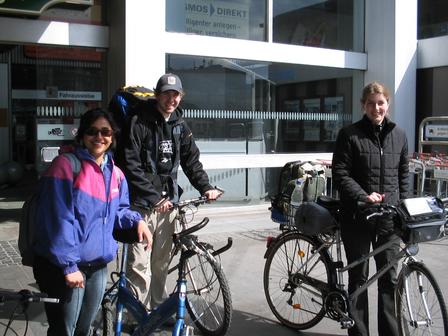
Here we are standing outside of the Hauptbahnhof in Saarbrücken. (Ashie, me, Caro)
|
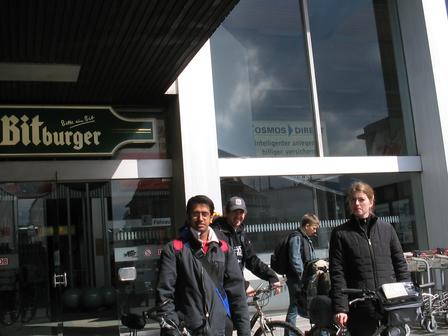
Same place, now Rakesh (Rick) is in the picture. We tried to get a sign in the background that said Saarbrücken, but I guess we have to settle for Bitburger, a brand of beer bottled in Saarland!
|
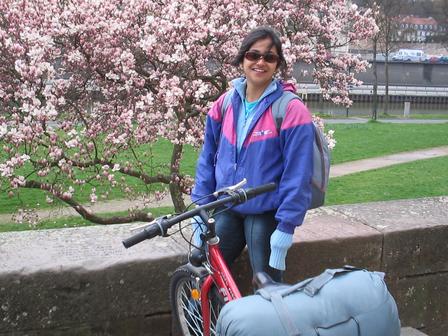
Still in Saarbrücken... This is just before we start biking along the Saar River (see in the background) in the wrong direction. We had gone several kilometers before we realized this mistake and had to turn around!
|
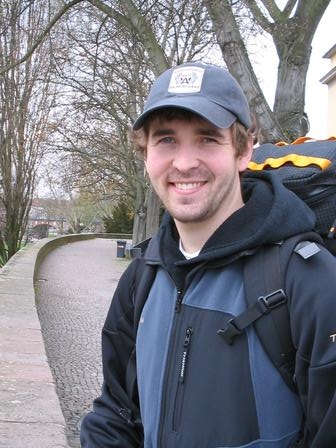
I guess we felt the need for some close-ups!
|
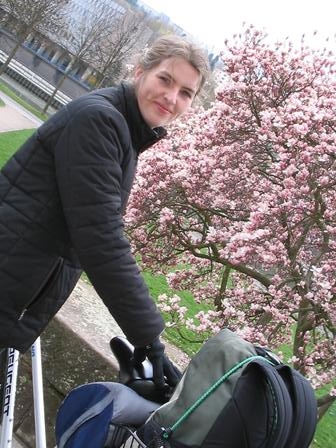
Caro poses for a picture.
|
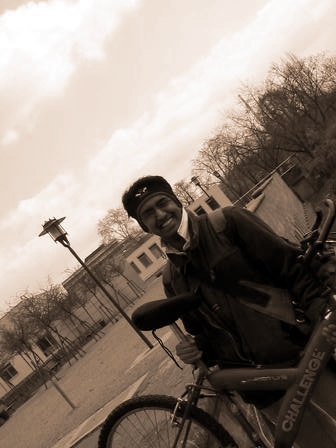
A black and white photo of Rick carrying his bike... Afterwards we showed him that you are suppose to sit on your bike rather then carry it. We started making good time after this...
|
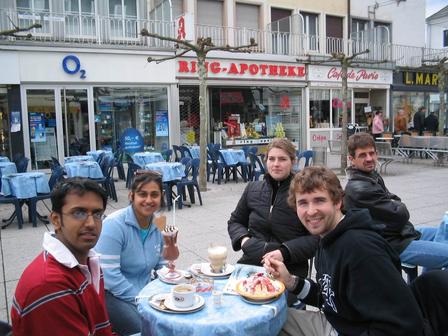
Ice cream in Saarlouis.
|
After ice cream in Saarlouis, the promise of rain in the dark skies, and the soreness of our backsides, promted a vote to be taken. We could continue on the river route to Merzig, the next big center with the promise of a Youth Hostel, or take a train to the City of Trier in the Rhineland-Pfalz region of Germany, North of Saarland. Merzig, being another 30km from Saarlouis, seemed an impossible goal for the moment and it was decided to take the easy route via train to Trier. Trier has the distinction of being the oldest city in Germany. Founded by Caeser Augustus in 15 B.C. under the name Treveris, it became the capital of the province of Belsica in the 1st century. In 275, Germanic tribes looted and destoryed Treveris, but 20 years later the city was reborn even more magnificently as one of three capitals (including York and Milan) of the Western Roman Empire. At this time, the Romans untook the construction of several enormous projects, including a town wall, several bridges, an amphitheater, and the Porta Nigra. Some years later, Treveris became an early center of Christianity under the rule of Emperor Constantine the Great. But the Middle Ages once again brought destruction at the hands of Germanic tribes. The name of the city was at this time shortened to Trier. It wasn't until the city came under the rule of Roman Catholic Archbishops in 802, that the city started to revive after its destruction. But in 882, Trier was once again destoyed, this time during a Viking invasion. And although Trier never again regained its former splendor, it still grew in the subsequent years. Now part of the Holy Roman Empire, Trier played host to several imperial diets and a university was founded in 1473. But the city suffered once again during the Thirty Years War (1618-1648) and finally occupied by the French during the French Revolution. After Napoleon's defeat in 1815, Prussian troops took control of Trier. In 1818, a man by the name of Karl Marx was born here, who would later go on to shape political ideals and thoughts for many years to come. The city once again prospered after the Franco-Prussian war of 1870, but was bombed heavily during WWI, after which it was once again occupied by French garrisons. In WWII, 40% of Trier was destoyed, but the historical significance of the city prompted its reconstruction and preservation shortly thereafter. Today, Trier is still a beautiful and magnificant city to behold. Amid the ruins of the Roman Amphitheater, lies endless underground labyrinths to explore. As well, the Catholic Cathedral is quite elaborate and the Porta Nigra almost perfectly preserved. Click here or here to read more about the history of Trier.
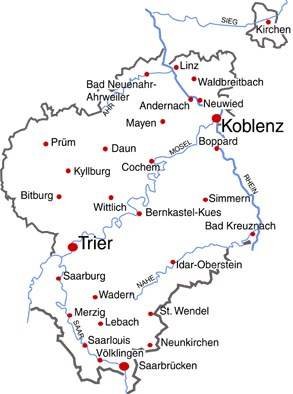
Once we arrived in this ancient Roman city, we attempted to find a Youth Hostel. After much searching, we located a nice place in the center of town. Soon after quick showers, we left to explore the city before it got dark. We found the Cathedral without much difficulty, but by the time we found the amphitheater it was closed to the general public and too dark to appeciate anyways. Going for beers in a small pub, we were soon prompted by sleepy heads to return to the hostel and get some rest in anticipation for the next day's journey! See below the pictures for our first day in Trier.
Pictures from the first day in Trier.
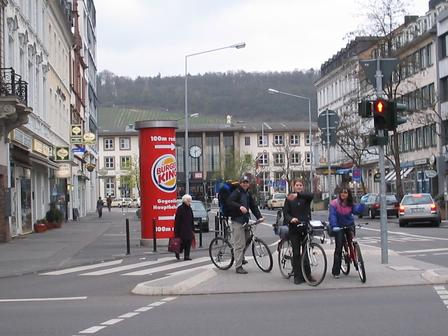
Just arriving in Trier. This Burger King sign actually dates back to the time of the Romans, and is quite well preserved.
|
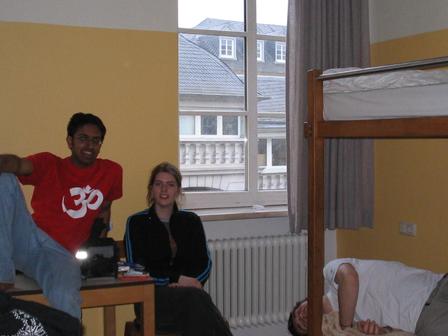
Our room at the Youth Hostel... I was only playing to be asleep... ; )
|
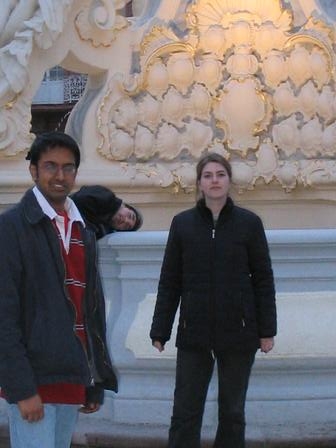
A magnificant fountain in the city center, and no I was not asleep on it!
|
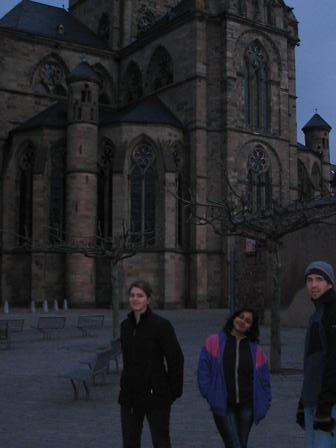
Here you can see some of the Roman Catholic Cathedral although it was getting quite dark and cold by this time...
Continue on to Day 2 by clicking here.
|